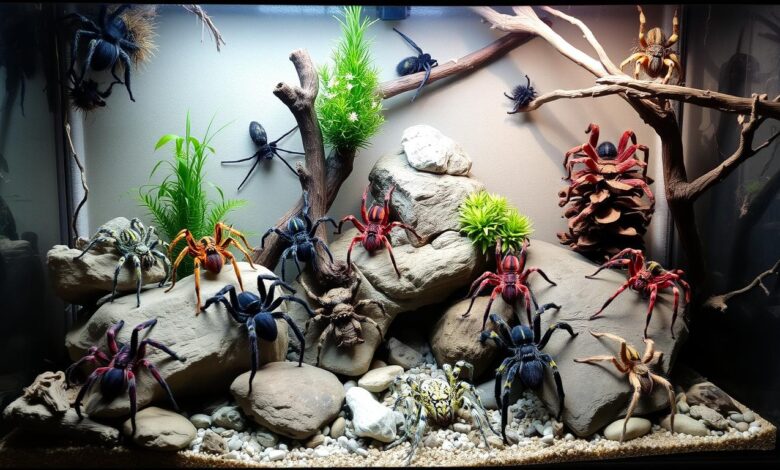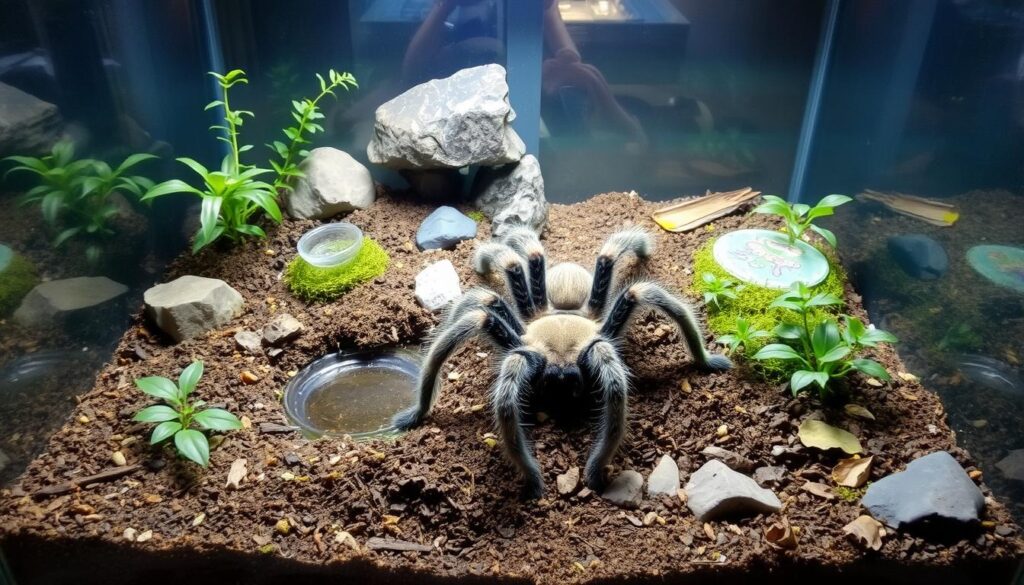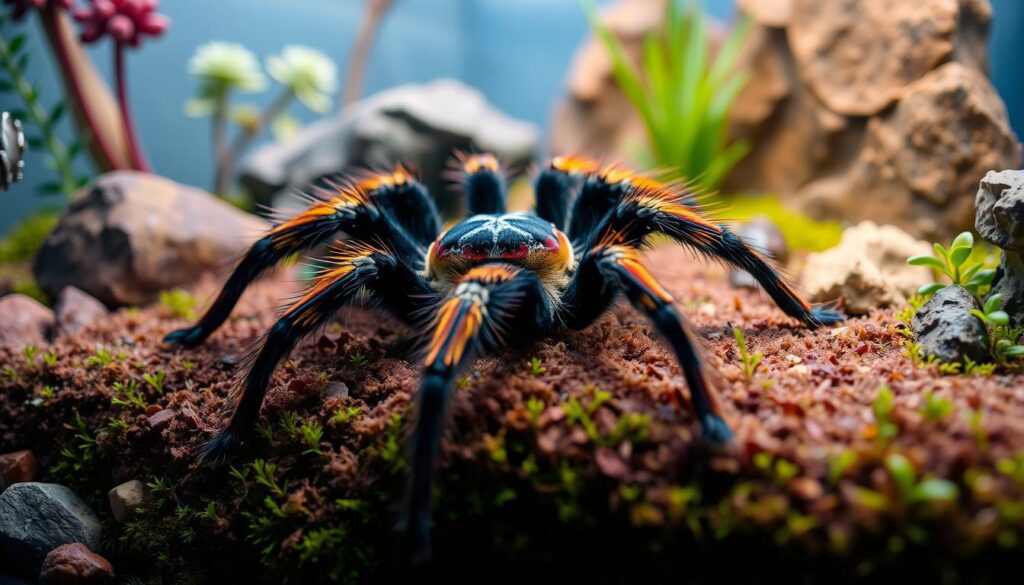Tarantulas as Pets: Advantages and Disadvantages

Tarantulas, part of the Theraphosidae family, are becoming more popular as pets. They come in over 1,000 species, making them a unique and interesting choice for many. But, owning tarantulas has its pros and cons. This guide will help you decide if a tarantula is right for you.
We’ll cover why these creatures are captivating and what care they need. This article is for both experts and beginners. It aims to give you the key info to decide if a tarantula should be your new pet.
Introduction to Keeping Tarantulas as Pets
Tarantulas have always fascinated people who love animals and nature. They are big, hairy spiders with a unique charm. Their size, behavior, and many species make them interesting. If you’re thinking about getting a tarantula, it’s important to understand what makes them special.
Understanding the Fascination with Tarantulas
People love tarantulas for their amazing look, how they move, and their interesting behaviors. They make for a unique and educational pet. They let us see the world of spiders up close.
Responsible Pet Ownership for Tarantulas
But, having a tarantula as a pet has its challenges. It’s important to think about the risks before getting one. You need to know about their homes, food, and how to handle them safely. You also need to be ready for their defensive actions and special care needs.
This section will give you a good idea of why tarantulas make great pets and what to consider before getting one.
Setting Up the Ideal Tarantula Habitat
Creating the perfect habitat is key for your tarantula’s health and happiness. You need to think about the right enclosure size, temperature, and humidity levels. Let’s look at what makes a great tarantula home.
Enclosure Requirements for Tarantulas
Tarantulas need specific enclosures to live comfortably. The rule is the enclosure should be at least 1.5 times the size of the tarantula’s leg span. So, a 4-inch tarantula needs a 6-inch or bigger enclosure. The enclosure should also be tall to let the tarantula burrow and move easily.
The substrate, or the material at the bottom of the enclosure, should be a mix that keeps the right moisture and drains well. Use a mix of coconut coir, peat moss, and vermiculite. This mix should be deep, about 2-3 inches, for the tarantula to burrow and feel at home.
Adding things like hiding spots, branches, and plants makes the habitat better. These items give the tarantula a sense of safety and let it act naturally.
Maintaining Proper Temperature and Humidity
Tarantulas can’t control their body temperature on their own. They need their environment to stay within a certain temperature range, between 72-86°F. It’s important to check the temperature often and adjust it to keep the tarantula happy.
Humidity is also key for tarantulas. They like a humidity level of 50-90%. You can keep the humidity right with a hygrometer and misting or water dishes in the enclosure.
By paying attention to the right enclosure and environment, you can make a great home for your tarantula. This ensures it stays healthy and happy for a long time.

Tarantulas as Pets: Advantages
Keeping a tarantula as a pet has many benefits for the right owner. These spiders are low-maintenance, needing less care than many pets. Their interesting looks and behaviors make owning them a rewarding experience.
One big plus of having a tarantula is how easy they are to care for. They don’t need as much attention as dogs or cats, making them great for busy people. With some research, you can easily meet their basic needs like the right enclosure, temperature, and humidity.
 Myths and Facts about Tarantulas
Myths and Facts about Tarantulas
Tarantulas are also fascinating to observe because of their unique behaviors and looks. They move slowly and have cool ways to defend themselves. Watching them molt, build webs, or hunt can be really interesting for those interested in owning a tarantula as a pet.
Another good thing about tarantulas is they are low-cost to maintain. They don’t cost much in terms of food, housing, and vet care. This makes them a great choice for people looking into the benefits of owning a tarantula.
In summary, the advantages of tarantulas as pets include easy care, interesting behaviors, and being affordable. For those ready to take on pet ownership, a tarantula can be a unique and fulfilling pet.

Tarantula Care and Handling
Caring for a tarantula as a pet needs specific knowledge and attention. It’s important to know how to feed and water them right. This ensures they get the nutrients and hydration they need to live well.
Feeding and Watering Requirements
Tarantulas eat live prey, like crickets, mealworms, and small rodents. The size of your tarantula will determine what it eats. It’s key to give them a varied diet to keep them healthy. Pay attention to how often you feed, as different tarantulas eat at different times.
Keeping your tarantula hydrated is also key. You can offer a shallow water dish or mist the enclosure to keep the water fresh. But, don’t overwater, as this can cause mold and health problems.
Handling Precautions
When handling tarantulas, be careful and move slowly. They are usually calm but can get defensive if scared. When you pick one up, move slowly and come from the side or back. Gently put the tarantula on your hand or a soft surface.
Some tarantulas are more defensive than others. Always wear gloves and make sure you and your pet are safe when handling them.
Learning about tarantula care and handling helps you create a safe home for your pet. This lets them live well and brings you closer to these amazing arachnids.
Tarantulas as Pets: Disadvantages
Tarantulas are fascinating but come with big challenges. Studies show that 2:9C67 of owners face issues with these exotic pets. They have to deal with various problems.
One big issue is their defensive behavior. When threatened, tarantulas can be very aggressive. This can be scary and dangerous for their owners. In fact, they are more likely to be attacked than owners of other pets.
Potential Risks and Challenges
Tarantulas need special care and a certain environment to live. This can be hard for many people. Keeping their temperature, humidity, and habitat right takes a lot of time and money.
There’s also a risk of getting bitten. Some bites can cause bad reactions or even emergencies. This, along with their special care needs, makes them hard for beginners in exotic pets.
Comparing owning a tarantula to other pets shows it’s not always a good idea. The challenges can be too much for those not ready for them.
Thinking carefully before getting a tarantula as a pet is important. These spiders are interesting but have big downsides. The data shows they might not be the best choice for all pet owners.
 Tarantulas for sale
Tarantulas for sale
Choosing the Right Tarantula Species
Choosing the right tarantula species is key when you want to keep them as pets. With over 800 different tarantula species out there, picking one that fits your experience and lifestyle is important. This guide will help you pick the best tarantula for you, focusing on beginner-friendly options.
Popular Tarantula Species for Beginners
For first-time tarantula owners, here are some easy-to-start species:
- Brachypelma smithi (Mexican Red-Knee Tarantula): It has bright red knees and is calm, making it great for beginners.
- Grammostola rosea (Chilean Rose Tarantula): This species is hardy, easy to care for, and gentle.
- Tliltocatl albopilosus (Curly-Hair Tarantula): It grows slowly and is gentle, perfect for beginners.
- Aphonopelma hentzi (Texas Brown Tarantula): Strong and easy to care for, it’s a good choice for new owners.
| Tarantula Species | Size | Temperament | Housing Needs |
|---|---|---|---|
| Brachypelma smithi | 5-6 inches | Calm and docile | Moist, well-ventilated enclosure |
| Grammostola rosea | 4-5 inches | Gentle and reluctant to bite | Dry, arid enclosure |
| Tliltocatl albopilosus | 4-5 inches | Calm and manageable | Moist, well-furnished enclosure |
| Aphonopelma hentzi | 5-6 inches | Docile and easy to handle | Dry, desert-like enclosure |
When picking a tarantula as a pet, think about size, temperament, and what they need for a home. The species listed are great for beginners, offering a good start into the world of tarantulas.
Tarantula Life Cycle and Behavior
Understanding the life cycle and behaviors of tarantulas is key to their care. These spiders change a lot, from tiny spiderlings to big adults. Each stage has its own challenges and ways of adapting.
The life of a tarantula starts with eggs, which can be a few dozen or hundreds. The tiny spiderlings that hatch need a lot of care. They grow and then shed their skin, a process called molting, to get bigger.
Molting is important for tarantulas to grow and get a new skin. During this time, they are very sensitive. Watching them molt can tell you how healthy they are.
As they grow, tarantulas show many interesting behaviors. Some dig tunnels underground to hide from predators and control their environment. Others live in trees, high up in the canopy.
Tarantulas are great at hunting. They use speed, agility, and venom to catch their food. They can feel vibrations and smells, helping them find food and move around.
Knowing about a tarantula’s life cycle and behaviors helps you take good care of them. This knowledge makes you appreciate these spiders more and enjoy having them as pets.
| Tarantula Life Cycle Stage | Key Characteristics |
|---|---|
| Egg | Tarantulas can lay anywhere from a few dozen to several hundred eggs, depending on the species. |
| Spiderling | Newly hatched tarantulas are tiny, fragile, and require meticulous care in their early days. |
| Molting | Tarantulas shed their exoskeletons to accommodate growth, a crucial process that requires careful monitoring. |
| Burrowing | Some tarantula species are known for their intricate underground tunnel systems, while others prefer an arboreal lifestyle. |
| Hunting | Tarantulas use their speed, agility, and venom to capture prey, relying on their unique senses to navigate their environment. |
Tarantula Breeders and Reputable Sources
Getting a tarantula as a pet means finding a good breeder or supplier. Responsible tarantula breeders give you healthy, ethically raised tarantulas. They also offer great advice on how to care for and breed them. This section will talk about why it’s important to work with trustworthy breeders. We’ll cover the benefits and what to look for when picking a good source for your pet.
Good tarantula breeders focus on the spiders’ well-being and use ethical methods. They know a lot about different tarantula species and their needs. Buying from a reliable source means your tarantula has been well taken care of. This lowers the chance of health or behavior problems later.
When looking to buy tarantulas, do your homework and find reputable sources. Choose breeders with a good name, positive reviews, and who are open about their practices. Stay away from buying on impulse from pet stores or online, as you can’t be sure about the tarantulas’ background or care. Instead, talk to experienced tarantula breeders. They can help you pick the right tarantula and offer support for your new pet’s needs.
Buying a tarantula from a reputable source has many advantages. These breeders know a lot about tarantulas and can share their knowledge on how to care for them. They help you pick the best tarantula for your level of experience and home. Plus, they make sure their tarantulas are treated ethically, so your new pet comes from a safe place.
Tarantulas as Pets: Cost and Considerations
Having a tarantula as a pet has its costs and things to think about. The first cost is the purchase price, but there are more expenses like housing, food, and vet care. It’s key to consider the financial side before getting a tarantula.
The cost of owning a tarantula changes a lot based on the type, size, and where you get it from. Small, common tarantulas like the Chilean rose can be $50 to $100. But bigger or rarer ones might be $100 to $300 or more. You also need to think about the cost of a proper enclosure, heaters, lights, substrate, and other supplies. These can add another $100 to $300 to your start-up costs.
Looking after a tarantula means paying for food, which can be $10 to $30 a month. Vet visits can also increase the cost. So, the total cost of having a tarantula as a pet can go into the hundreds or even thousands over its life.
 What does the tarantula eat?
What does the tarantula eat?



